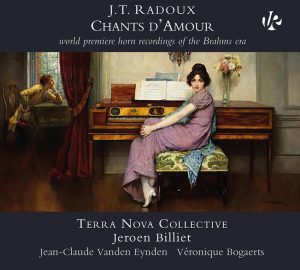 Terra Nova Collective, Chants d’Amour (Self-published, 2016)
Terra Nova Collective, Chants d’Amour (Self-published, 2016)
Joroen Billiet, historical horns, Jean-Claude Vanden Eynden, piano, Véronique Bogaerts, violin, Mark De Merlier, early valve horn, Marjan De Haer, harp
Recorded 3-4-5 November, 2015 in AMUZ-Augustinas Muziekcentrum Antwerp
This recording, featuring historical hornist Joroen Billiet, brings together a fine collection of works that reward the listener with wonderfully “lyrical” melodic lines reminiscent of the vocal literature. These pieces are rather different from the operatic fantasias of Gallay, seeming more in line with the vocalises of Cancone or Bordogni. As stated on the inner cover of the CD jacket, “The playlist of Chants d’Amour is based on the concert repertoire performed by [the] legendary Liègeois horn player, admired by Johannes Brahms”, Alphonse Stenebruggen. Five of the works on this CD are world premiere recordings, and each of the pieces will be made available for purchase by Golden River Music.
The brass instruments heard herein include horns from the workshop of Courtois frère of Paris and that of Ferdinand Van Cauwelaert of Brussels. In fact, there are two horns from Cauwelaert, one an original instrument built ca. 1870, and another that is a modern reconstruction built by Daniel Kunst of Bremen. Both of the Cauwelaert horns are played with Périnet valves, one set of two valves and one of three valves, respectively. Additionally, a historic Bechstein piano from 1889, an Erard harp ca. 1880, and a Jean Baptiste Roggerius violin dating from 1699 (Amati school) are utilized by the players. A clarinet is heard in the first track, but unfortunately no listing is given for the player or the instrument.
Billiet’s playing is consistently satisfying throughout this CD. His rich tone quality, sensitive phrasing, impeccable intonation in both open and stopped tones, and adept technicality make this an enjoyable collection of music from beginning to end. The world premiere recordings are a true benefit to the profession and will surely serve as a reference point for hornists seeking interesting repertoire when building recital programs. Of particular interest in this recording is Billiet’s attention to the place that the horn tradition of Liège fits within the broader picture of horn playing in 19th century Europe. He makes a point in the accompanying liner notes of discussing the fact that the Liègeois school of horn playing placed equal emphasis on both natural and valved horn technique, allowing the two instruments to inform the other’s playing style. It is an interesting approach to hear these recordings in that context, especially when one considers the often stark separations between natural horn and valved horn playing that occurred in much of Europe during the latter half of the 19th century.
-- Eric Brummitt



